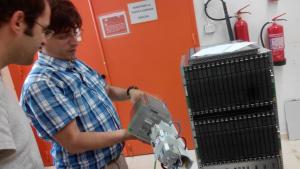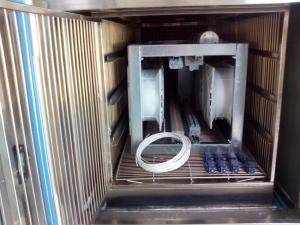Nuclear safety electronics weather rough tests
For some of ITER's nuclear safety control electronics, it has been rocky weather recently.
In the climate-controlled chambers of Applus+ Laboratories in Barcelona, control logic components have been undergoing fast temperature variations between -25°C and 70°C, then weathering 70° C heat for ten days, followed by damp heat for six days, and finally a return to -25°C for several hours. And if that wasn't enough, vibration tests have subjected the devices to mechanical stresses equivalent to those expected over the entire lifetime of ITER.
Although not common for electronics, these conditions are intended to submit the components to aggravated environmental conditions, effectively "ageing" them as if they had been used for several decades in industrial conditions.
The rough treatment is the first step in a series of tests intended to demonstrate that ITER's control logic electronics will continue to perform their functions flawlessly in case of a seismic event. The ageing tests, which began in July, will be followed by seismic tests in 2016 as part of environmental qualification that the Control System Division is performing with its contractor, the Spanish consortium Empresarios Agrupados/Inabensa.
The Nuclear Safety Control System will be delivered primarily by the ITER Domestic Agencies (90 percent), with approximately 10 percent procured by the ITER Organization Central Team.
To support the Domestic Agencies in the procurement of the system and mitigate integration and qualification risks, the ITER Organization has selected two different technologies for the implementation of PIC control logics. In both cases, looking for cost effectiveness, the Central Team selected best-in-class industrial products through international call for tenders and is now performing the prequalification activities. The products (HIMA Planar 4 safety modules for highest importance PIC functions and Siemens Safety PLC for lower) can be used by all Domestic Agencies.
By respecting applicable technical rules in order to stay inside the prequalification demonstration, qualification processes will be facilitated.
The Central Team will continue to work on the demonstration that the product design, testing, and manufacturing all meet the requirements for the project's nuclear safety Instrumentation and Control (I&C) functions and the licensing of the system.
And the samples will continue to weather demanding ageing tests. After the temperature variation, they will be subjected to prolonged operation for 40 days at maximum temperature and maximum voltage. These ageing tests will then be followed by stringent electromagnetic compatibility tests—representative of lightning striking the buildings—and finally magnetic field tests. In 2016, the contracting consortium will be charged with final seismic tests on full-size control logic cubicles.



